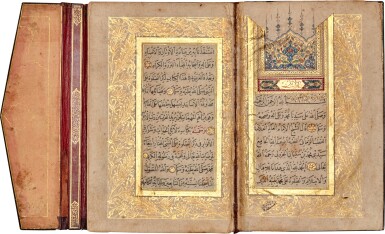
An Ottoman illuminated prayer book including Dala'il al-Khayrat and al-Hizb al-A'zam of 'Ali al-Qari, copied by al-Hajj Muhammad, known as Imamzadeh, Edirne, Turkey, dated 1208-09 AH/1793-95 AD
Estimate
8,000 - 12,000 GBP
Lot Details
Description
Arabic manuscript on paper, 166 leaves, plus 2 fly leaves, 11 lines to the page written in naskh in black ink, keywords picked out in red, verses separated by gold roundels with red and blue dots, within gold, black and blue rules, further text divisions marked by gold and polychrome illuminated panels, ff.1b, 18b and 94b each with a gold and polychrome illuminated headpiece, ff.15b and 16a with full page illustrations of Mecca and Medina, in gilt and painted brown leather binding with flap, cream paper doublures, in modern green box
16.2 by 10.8cm.
In the colophon of this prayer book the scribe al-Hajj Muhammad, known as Imamzadeh, records that he served as the imam of the Muradiyeh mosque (jāmi‘) and that he committed the Qur’an to memory (bi-ḥāfiz al-Qur’ān, see Uğur Derman 2009, p.124). He is almost certainly the same scribe as Hafez Muhammad ibn Hafez Ibrahim al-Mawlawi, known as Imamzadeh, who in 1770-71 copied an An‘am Sharif prayerbook while the imam of the Muradiyeh mosque (jāmi‘) in Edirne (Millon Paris, 13 December 2022, lot 398).
At least one student of al-Hajj Muhammad is known through an illuminated Qur’an manuscript completed in 1236 AH/1820-21 AD by Hafiz Muhammad al-Farid, who records that he is from among the students of al-Hajj al-Hafez Muhammad, the imam of Muradiyeh mosque in Edirne (Sotheby’s London, 27 October 2021, lot 124).
Approximately halfway through the manuscript, between the Dala'il al-Khayrat and al-Hizb al-A'zam sections, on ff.92b and 93a, a note by a later owner, Seyyid Mehmed Tahir Balchiqli (“of Balchik”, on the modern-day Bulgarian coast), is recorded in a neat naskh, stating that he licensed a certain Osman Pasha in the correct reading of the Dala'il al-Khayrat. The note is dated 1263 AH/1847-8 AD and accompanied by Mehmed Tahir’s personal seal.
You May Also Like



![An extremely rare illustrated manuscript of the Ka'banameh (A history of the Ka'ba) by Abdulrahman Gubari (d.1566), signed by Ahmad [...] al-Khatib, Kaposvár, Hungary, dated Dhu'l-Hijjah 1080 AH/April-May 1670 AD](https://dam.sothebys.com/dam/image/lot/1e33ac28-a449-4673-a23f-f1ca4d5a13b3/primary/extra_small)






